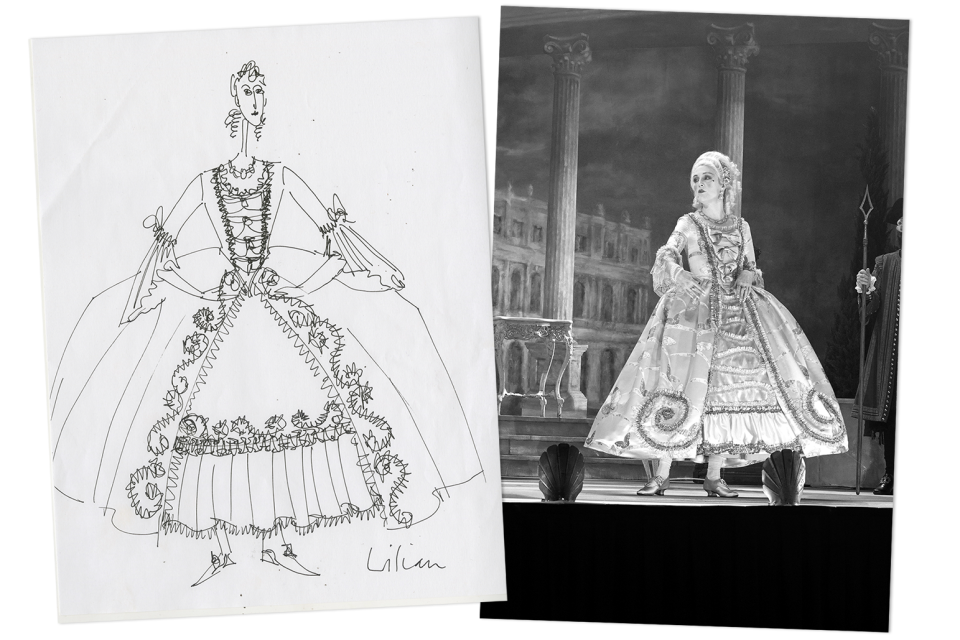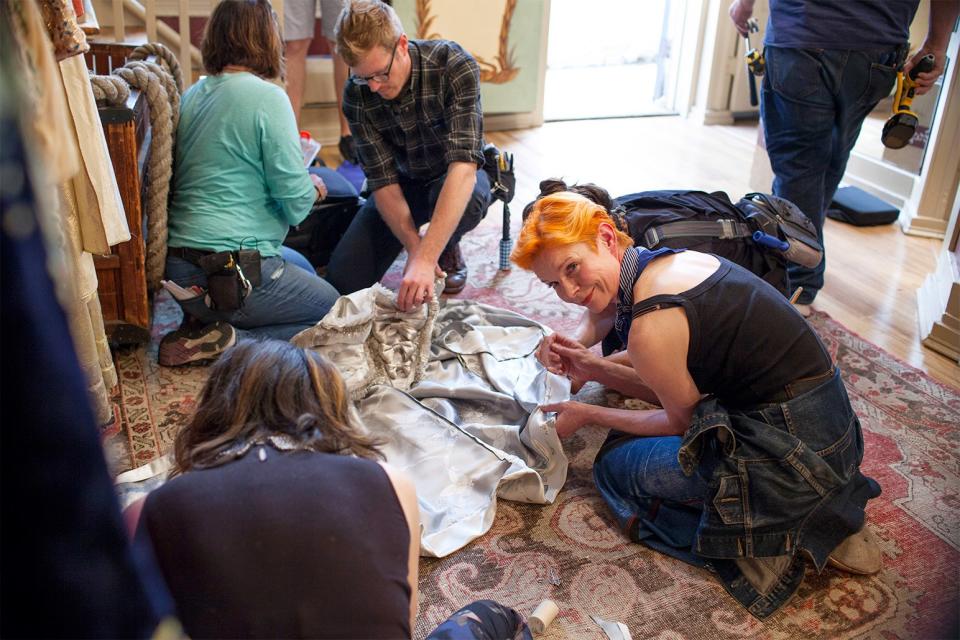How Sandy Powell, Oscar-Winning Costume Designer, Ventured Outside Her Comfort Zone
Photos: Courtesy.
English costume designer Sandy Powell has been operating in the top tier of filmmaking for the past 23 years, ever since she earned her first of 12 Oscar nominations for outfitting Tilda Swinton in the gorgeous period-jumping fantasy Orlando. In the years since, Powell has won three Academy Awards (for Shakespeare in Love, The Aviator, and The Young Victoria); collaborated with some of the best living directors (including Martin Scorsese six times); and intricately transformed hundreds of actors for dozens of eras, each obsessively researched so that she could meld whimsy with realism. But with Wonderstruck, the Todd Haynes-directed adaptation of Brian Selznick’s graphic novel, Powell thrust herself into entirely new territory. Not only did Powell design costumes for the black and white format (which makes up half of the film), but she also executive produced the ambitious project—her first time working in that capacity—after setting the wheels for the adaptation in motion herself.
“I knew Brian’s previous work because I’d done the costumes for Martin Scorsese’s adaptation of Brian’s other book, The Invention of Hugo Cabret,” Powell explained to Vanity Fair by phone last month. “Brian and I became friends during that process. I then read his second book, Wonderstruck, and instantly realized that this could make a really interesting if not challenging film.”
Selznick’s 2011 novel is split into two story lines, each set in a different period, centered on different deaf characters, and told through a different style. One thread unspools in black and white illustrations, following movie-obsessed Rose (played in the film by Millicent Simmonds) as she ventures into Manhattan alone in 1927—the same year that films gain sound and Rose is heartbroken to discover that she can no longer experience movies like other audience members. The second narrative, told in words and set in 1977, chronicles Ben (played in the film by Oakes Fegley) as he travels to Manhattan in search of clues about his long-lost father.
“I just thought this would make an interesting story, with the two different periods running concurrently,” said Powell, who convinced Selznick to tackle the screenplay himself—a first for the author and graphic artist—and encouraged him through the process.
“Once he finished, I said jokingly, ‘Oh I’ll produce it for you,’” remembered Powell, who brought the script to filmmaker Haynes, with whom she previously collaborated on Velvet Goldmine, Far from Heaven, and Carol.
“Whether he was interested or not, I hoped that he could at least give us some ideas or pointers,” said Powell. “But he read it and and loved it straight away.”
Executive producing, Powell said, came quite naturally to her.
“I’ve been in the film industry for about 30 years, and during that time, you do tend to find yourself looking at the film as a whole. I don’t just look at films in terms of costumes. I tend to be interested in the other production aspects and wanting to control those,” Powell said with a chuckle. “Often I think, ‘Well, I wouldn’t have done it like that’ or ‘If I had the choice . . . ’ In the past, when I’ve been a costume designer, it wasn’t fair for me to meddle with other departments. But I really enjoyed talking about casting on Wonderstruck, watching audition tapes, and getting a voice in creative decisions outside of costume.”
To remain true to the graphic novel’s bifurcated format, the filmmakers differentiated the adaptation’s story lines by shooting Ben’s story in a 70s-appropriate color palette of oranges, mustards, and browns, while Rose’s narrative was filmed in black and white.
“This is the first time I’ve worked in black and white, so I had to unlearn everything I’ve come to know about costume designing for color and start over,” explained Powell. She and Haynes poured over street photography and documentaries from both eras for research. “I normally start with color, after I’ve met the actors. When I started working with Millie, who played Rose, I couldn’t help but put colors that appealed to me together. It looked lovely in person—but then you take a photograph, turn it into black and white, and realize that it actually looks quite dull. I quickly realized that you had to play around with contrast, tone, and texture more than color.”
“It made it easier when we dressed crowds, because you could put two colors together that you would never normally dream of doing. Or I could use contemporary gloves that were in very bright leather colors that wouldn’t have been around,” said Powell, adding that she couldn’t turn off the part of her color-costume-design brain entirely. “Having said that, it did bother me when I was on set and I saw colors that looked horrible together. With Rose’s costume, I worked it out tonally but still managed to get the colors to work together because I knew there’d photographers taking picture on set occasionally that would be published in color. So I kind of, rather stupidly, made it work both ways—in color and black and white.”
Because she was dressing child actors, Powell had to work within other parameters—like refraining from vintage items, since she needed to create multiple costumes for the growing actors and their doubles, who relieved the kids each day after they reached the number of hours they could legally film. Powell also had to cycle through shoe sizes to accommodate the stars’ growing feet, and determine how to tell each character’s complete story in a single costume design—since the protagonists did not have wardrobe changes. All in, Wonderstruck was a welcome exercise in new creative muscles for Powell, from both the costume and overall production perspectives.
Asked whether Powell would produce again—or even direct—the Oscar winner admitted that she does have an idea for a future film, “but it’s a bit of a terrifying prospect.”
After a beat, she added, “I think it is actually quite good to do things that terrify you though, isn’t it? I’ve been doing costume for many, many years, and I’m comfortable with it. . . . But I think of costumes as being one element of a world, and I’m interested in the rest of the world, too.”
This story originally appeared on Vanity Fair.
More from Vanity Fair:
13 Photos That Prove William and Kate Are a Perfect Couple
The Game of Thrones Cast Then and Now
The 20 Most Satisfying TV Kisses of All Time
Film's Sexiest Little Black Dresses


